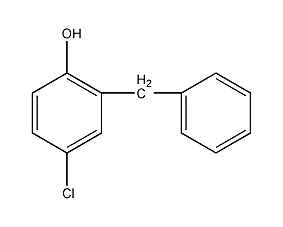2-Benzyl-4-chlorophenol


Structural formula
| Business number | 03BZ |
|---|---|
| Molecular formula | C13H11OCl |
| Molecular weight | 218.68 |
| label |
4-Chloro-2-benzylphenol, 2-Benzylchlorophenol, 4-Chloro-2-(phenylmethyl)phenol, chlorobenzylphenol, Benzylchlorophenol, 2-Benzyl-4-chlorophenol, Chlorophene, 4-Chloro-2-(phenylmethyl)phenol, benzyl-p-chlorophenol, aromatic compounds |
Numbering system
CAS number:120-32-1
MDL number:MFCD00020140
EINECS number:204-385-8
RTECS number:GO7175000
BRN number:None
PubChem number:24879046
Physical property data
1. Appearance: white crystalline powder .
2. Density (g/mL,20℃): 1.19
3. Relative vapor density (g/mL,Air=1): Undetermined
4. Melting point (ºC): 46- 49
5. Boiling point (ºC,normal pressure):160-162
6. Boiling point (ºC,kPa): Undetermined
7. Refractive index: Undetermined
8. Flashpoint (ºC):185
9. Specific rotation (º): Undetermined
10. Autoignition point or ignition temperature (ºC): Undetermined
11. Vapor pressure (mmHg,25ºC): Undetermined
12. Saturated vapor pressure (kPa, ºC): Undetermined
13. Heat of combustion (KJ/mol): Undetermined
14. Critical temperature (ºC): Undetermined
15. Critical pressure (KPa): Undetermined
16. Oil and water (octanol/Log value of the partition coefficient for water: undetermined
17. Explosion upper limit (%,V/V): Undetermined
18. Lower explosion limit (%,V/V): Undetermined
19. Solubility: Undetermined
Toxicological data
1, acute Toxicity: Rat oral LD50: 1700mg/kg
Ecological data
This substance is harmful to the environment. It is recommended not to let it enter the environment. Special attention should be paid to the pollution of water bodies.
Molecular structure data
5. Molecular property data:
1. Molar refractive index: 62.34
2. Molar volume (m3/mol):179.2
3. isotonic specific volume (90.2K):469.2
4. Surface Tension (dyne/cm):46.9
5. Polarizability(10-24cm3):24.71
Compute chemical data
1. Reference value for hydrophobic parameter calculation (XlogP): None
2. Number of hydrogen bond donors: 1
3. Number of hydrogen bond acceptors: 1
4. Number of rotatable chemical bonds: 2
5. Number of tautomers: 3
6. Topological molecule polar surface area 20.2
7. Number of heavy atoms: 15
8. Surface charge: 0
9. Complexity: 189
10. Number of isotope atoms: 0
11. Determine the number of atomic stereocenters: 0
12. Uncertain number of atomic stereocenters: 0
13. Determine the number of chemical bond stereocenters: 0
14. Number of uncertain chemical bond stereocenters: 0
15. Number of covalent bond units: 1
Properties and stability
Avoid contact with oxides and acids.
Storage method
Save sealed in a cool, dry place. Make sure the workspace has good ventilation. Keep away from fire sources and store away from oxidants and acidic substances.
Synthesis method
None
Purpose
Used as pesticides and pharmaceutical intermediates
t-family: Arial; mso-hansi-font-family: Arial; mso-bidi-font-family: Arial”>):179.2
3. isotonic specific volume (90.2K):469.2
4. Surface Tension (dyne/cm):46.9
5. Polarizability(10-24cm3):24.71
Compute chemical data
1. Reference value for hydrophobic parameter calculation (XlogP): None
2. Number of hydrogen bond donors: 1
3. Number of hydrogen bond acceptors: 1
4. Number of rotatable chemical bonds: 2
5. Number of tautomers: 3
6. Topological molecule polar surface area 20.2
7. Number of heavy atoms: 15
8. Surface charge: 0
9. Complexity: 189
10. Number of isotope atoms: 0
11. Determine the number of atomic stereocenters: 0
12. Uncertain number of atomic stereocenters: 0
13. Determine the number of chemical bond stereocenters: 0
14. Number of uncertain chemical bond stereocenters: 0
15. Number of covalent bond units: 1
Properties and stability
Avoid contact with oxides and acids.
Storage method
Save sealed in a cool, dry place. Make sure the workspace has good ventilation. Keep away from fire sources and store away from oxidants and acidic substances.
Synthesis method
None
Purpose
Used as pesticides and pharmaceutical intermediates
